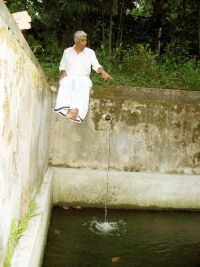Coffee planter M P Chandranath's feat has very few parallels in the country. He developed a forest only to augment his water sources. For this purpose, he had least hesitation to sacrifice six acres of his prime coffee plantation.
Chandranath owns 45 acres of coffee estate near Kalpetta, in Wayanad, Kerala. It is located on a hill named Puliyarmala. Apart from coffee, he grows arecanut, cardamom, coconut, etc. For coffee cultivation, getting timely rains in early summer during the time of inflorescence bloom called blossom shower - is very important. But rains can be erratic, and planters who have enough water sources usually provide artificial rain (irrigation) at this time with the help of sprinkler jets.

![]() Chandranath in the backdrop of a thick forest grown by him where a coffee plantation stood decades ago. Pic: Shree Padre.
Chandranath in the backdrop of a thick forest grown by him where a coffee plantation stood decades ago. Pic: Shree Padre.
Unfortunately Chandranath's estate doesn't have a river nearby. Nor does he have other sources of abundant water to provide blossom showers. (The rain showers that usually come in February also stopped.) Chandranath then started his own method. He laid underground pipelines to carry water from water tanks through the estate, providing blossom irrigation for the coffee plants. At the right time, workers would manually drench the coffee plants once. Initially he was able to irrigate only 3-4 acres of his coffee plants. But after the development of forest and increase in his supply of water, he is able to cover about 20 acres, a major portion of his estate. "We can't afford sprinkler raining since we don't have lot of water. This method of our own has given us encouraging results," says Chandranath. Now, he has water enough to give this sort of blossom shower for 20 acres of his coffee plantation.
The story goes back to about one and half decades. There was not enough water to extend his simple method of blossom irrigation (using pipelines) to whole of the estate. They could hardly irrigate a few acres. In 1992, one of the biggest water sources of his estate, flowing from a valley within his land dried up in summer. A shocked Chandranath didn't know how to solve his water crisis.

•
Coffre sails globally, sinks locally
•
Will live ballots revive economy
If water source has to be improved, learnt Chandranath, a forest has to be developed in its catchment area. In Chandranath's case, the catchment area of his main water source, a huge valley, was already fully covered with coffee plantation. But that didn't discourage him. He started planting many forest trees in between. Today, after 14 years, an area of approximately four acres has grown into a thick forest. As the forest trees grew, the water source improved. It's running bountifully since more than 9 years.
"There is 15 years effort behind this mini-jungle", explains Chandranath. Most of this area is rock-laden. Top soil depth is very less. The sandy-loam soil loses moisture very early. As such he had to irrigate the forest plants. Once a week from January to April. While planting, cow dung was applied. Small doses of chemical fertilizer once a year in the next two years. "If you take care and do this much of maintenance" points out he, "then the forest will grow on its own."
In fact, most of the trees have grown quite bigger for their age. Probably the fertility of the soil is also responsible for this. We are now standing at the borderline that separates Chandranath and his elder brother's properties. "Look to the other side. It's my elder brother M P Veerendrakumar's estate. Our valley too had similar kind of coffee plants with luxuriant growth." he recalls. "Where are they now? Most of them have vanished," he adds, pointin to the appearance. From the gaps in between the coffee plants, a thick forest has come up. Now, you can't see the coffee plants amidst this forest. Points out he, "In areas where there are chances of soil erosion, we haven't uprooted the coffee plants. We have trimmed them a bit."

![]() Chandranath pointing out an augmented water source which had totally dried up earlier. Pic: Shree Padre.
Chandranath pointing out an augmented water source which had totally dried up earlier. Pic: Shree Padre.
If the coffee plants were uprooted, it would have exposed fresh soil into open and in monsoon, this lose soil would get washed away, causing considerable soil erosion. The canopy cover of pruned coffee plants protects the soil beneath from eroding, thus conserving the fertility. "In areas where there are chances of soil erosion happening, we haven't uprooted them. We have trimmed them a bit," says Chandranath.
Is afforestation the only method Chandranath has adopted?
"No. Follow me to see from what distance I have started my treatment", he takes me about hundred meters above along the the sloping land. It has a patch of areca garden apart from coffee. In the slope above the valley, a number of big contour trenches are visible, in between the coffee plants. But in the areca garden, for every three rows, he has converted the land into platforms, for two purposes. When it was a sloping land as earlier, most of the rainwater would have run-off because the arecanut tree canopy can't check even one third of the rainfall. Platforms, on the other hand, don't allow the rainwater to run-off so easily; the water percolates there itself. Lesser run-off means lesser soil-erosion as well. Unlike in coffee estates, digging big trenches wouldn't suit to areca gardens as there are many agricultural operations to carry out inside and trenches would prove risky.
Chandranath has planted Mango, Jack, Mahogany, and other varieties of seedlings he could get. Local species got the highest priority. In the initial 3-4 years he manures them and occasionally gives a few irrigations in summer.
"Most of the trees I have planted are of low-timber value. In future nobody should be tempted to cut off the painstakingly developed forest for its timber value", he says. Wherever there is space, a tree species is planted. In total, Chandranath has developed mini-forests in 5 spots in his property. One of these is just by the Kalpetta Mananthavady roadside. "This one I have developed just as a demonstration for the people traveling on the road. Let them see and learn that only by preserving trees you can have water."
Six years ago, water in his well dried in February. As a result, he had to bring drinking water from far away place. Adjoining his well is an old arecanut garden. Still above that is a valley. "One has to make the treatment depending on the specific local conditions. See, swampy lands are very common in Wayanad. Arecanut and banana plants are not suitable for such places. I gave up hopes of my areca plantation." Chandranath started planting plants like reeds (Ochlandra travancoria) that survive well in such conditions. These reeds grow 7-8 feet in three years. Uravu, a local bamboo handicraft organization buys these reeds for making handicraft items.
Apart from planting reeds in the areca gardens, he has planted trees in the valley above. All these efforts have helped him check rainwater and made his well rich in water now. To further exploit the rainwater, Chandranath had a huge tank dug on the lower side. This tank has full of water all the months. "I have kept it as a reserve. I will use it only if there is water scarcity in other water sources", he says.
Chandranath has another property at Mattappara where they have arecanut cultivation. Though it's a level land, it's swampy. There also he has planted reeds in two acre of arecanut garden to check the rain. As a result, the water sources have improved. He is able to irrigate the 10-acre arecanut garden now with drip irrigation.
"In fact, we need one acre of thick forest for every 5 acre of coffee plantation. But then, practically this is very difficult to maintain. At least we should conserve or develop one acre of forest for 10 acres of coffee plantation", he advises.
"The reason is very simple. A coffee plantation cannot check rain as efficiently as a natural forest. How many (water) tanks you have in your coffee estate is not the main point. What is very important is to ensure that catchment areas of these tanks catch rain properly only we maintained the 'cradle pits' (infiltration pits) inside the coffee plantation, that would have been a very effective way of checking rainwater in-situ," he says. When compared to artificial measures of rainwater harvesting, getting it done through natural way, that is, through forests, is the best way, says Chandranath.
Chandranath goes on to analyse the drought in Wayanad district. He says that before the 1950s Wayanad didn't have a water problem at all. In the '50s people from south Thiruvancore came and settled in Pudpally, Mullankolli, Kanichchara and nearby belts. The first thing they did was to shave of the existing thick forest. Tapioca cultivation sent all the topsoil away. They then planted the Dadop tree and started pepper cultivation by spreading that vine onto these trees, notes Chandranath. "A hundred Dadop trees can't equal a natural forest tree in its silent works like conserving soil, water and coolness. Rampant deforestation is the main reason behind today's severe drought of Wayanad. The second main reason is banana cultivation. All the water that was earlier checked by the paddy fields is now drained out to cultivate banana," says Chandranath.
"Everybody talks about water, but nobody does any serious work. I have shared my experiences of developing forest and the subsequent benefits. Don't plant cash crops in the sloping catchments areas is what I always keep says to my fellowmen here. But nobody seems to be taking it seriously."

![]() Chandranath. Pic: Shree Padre.
Chandranath. Pic: Shree Padre.
But is it not a huge loss to lose more than 6 acres of good coffee plantation for the sake of a forest?
Chandranath smiles. "Let it go, I don't mind at all. You calculate. What's the maximum income I can get from these six acres? Is not water more precious than that? If you have water, you can grow many crops. By sacrificing six acres, if I can irrigate 20 acres, why not? After all these six acres is out of the forty five acres I have."
What would have happened if he didn't opt or this 'forest cultivation'? Chandranath has a ready answer." See we often read news of ever-flowing big rivers drying up. When the reality is like that, what would have been the fate of our small water flows? Our sources would have dried; farming would have been in deep crisis. The confidence what we have today wouldn't have been there. See now. Even if the rains are a bit erratic or low, we are not worried. Our water-flow remains unaffected," he says.
May it be arecanut, coconut or coffee, we have many farmers who first develop the garden, then try exploring for water. Chandranath totally disagrees with this approach. 'First is water, then the garden', he puts the priorities right. "Check the water availability; try to augment or maintain the water by developing mini forests in its catchments. Then decide on the extent of garden, type of crop etc everything after the water availability is ensured", he suggests.























